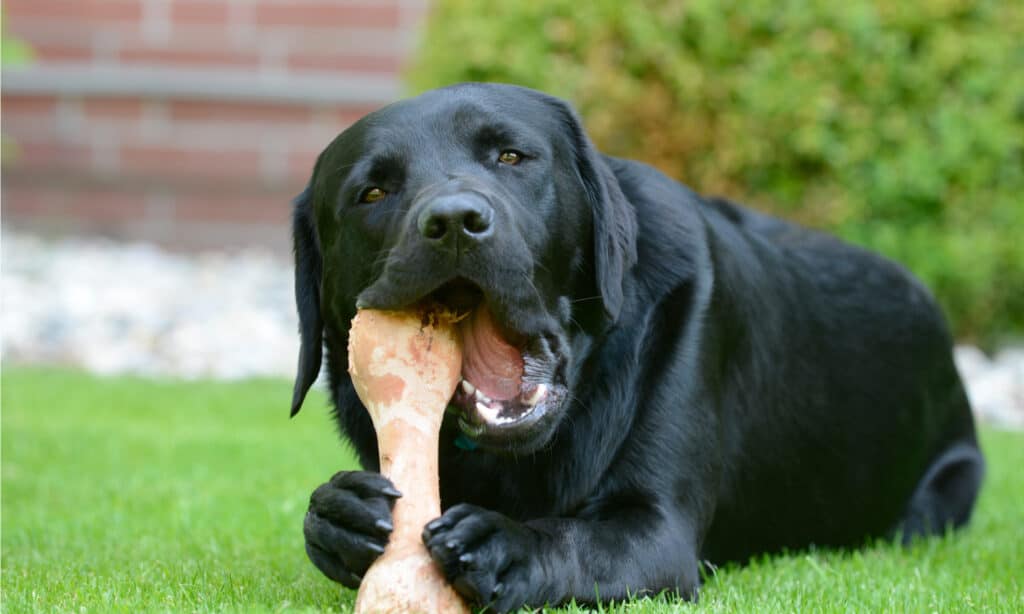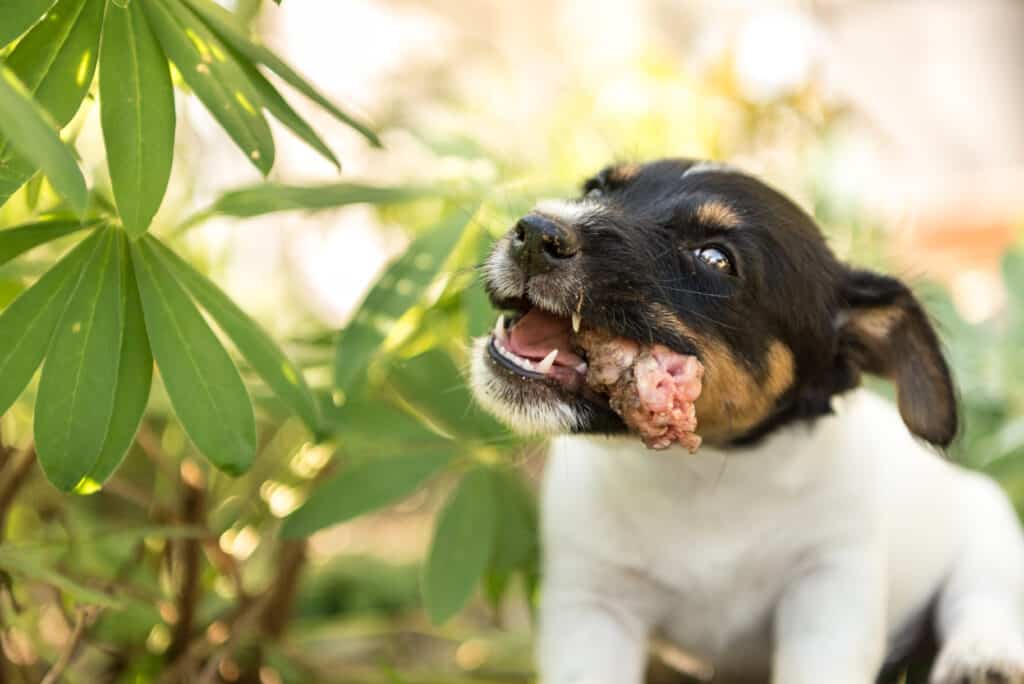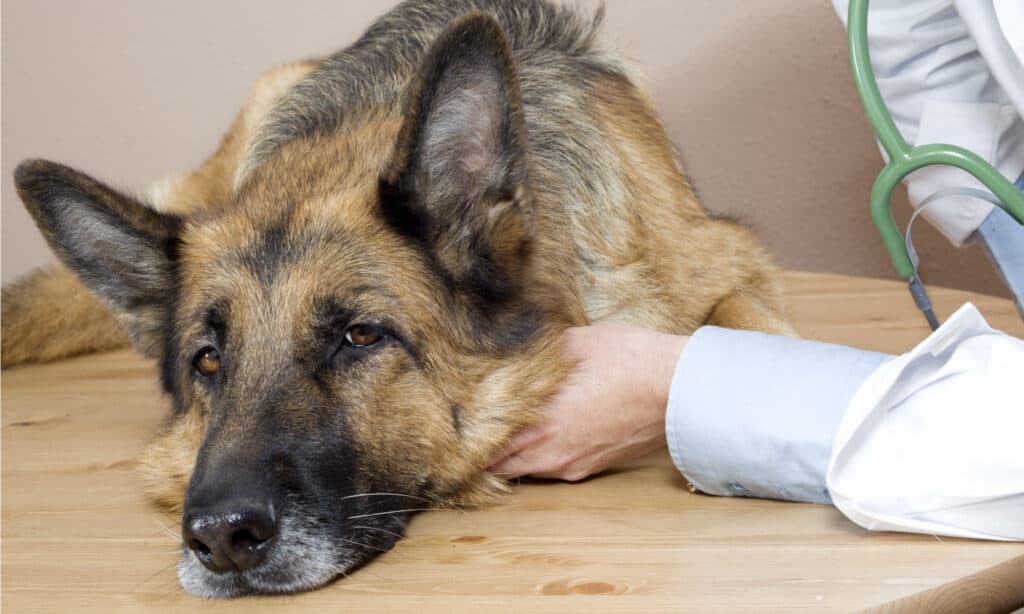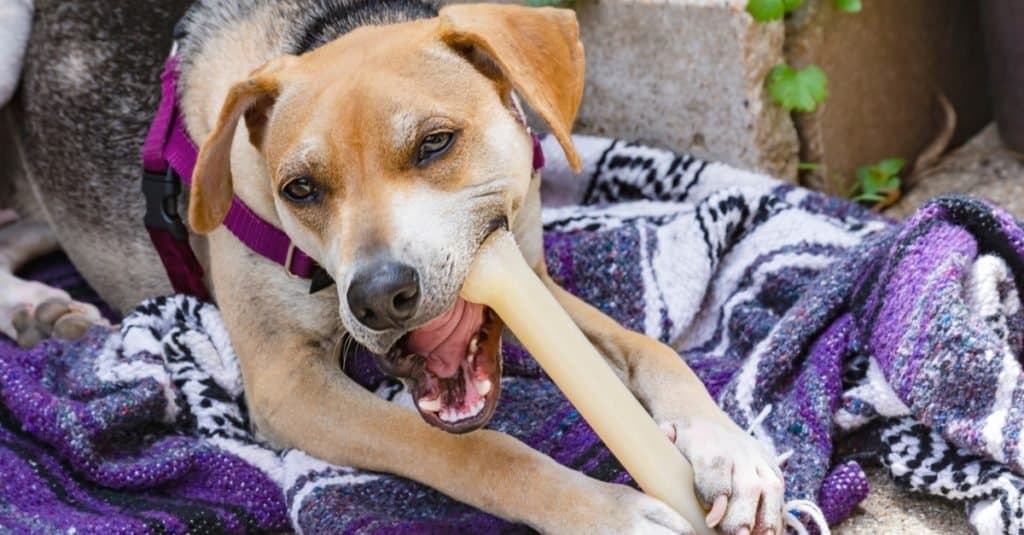There’s a common stereotype across all media forms: dogs love bones. Many appearances of dogs in cartoons and movies show them gnawing away on a ham bone the size of their head or stealing bones off the table at a Christmas dinner. The stereotype exists for a good reason: chewing on bones is excellent for your dog’s dental health and digestion! But did you know that unlike in the movies, ham bones can be hazardous for dogs if you aren’t careful?
That’s right; giving your furry friend the bone from your festive feasts can have serious consequences, including death. Read on to find out why this is and how to safely give your dog the benefits of chewing on a bone while minimizing the risks to their health.
What Happens if a Dog Eats a Ham Bone?

Dogs and wolves have strong teeth that can chew through bones.
©schubbel/Shutterstock.com
Animals in the canine family, like wolves and dogs, have evolved to have a very impressive trait: teeth that can chew through bones. Their sharp incisors are built for it, allowing them to eat their prey efficiently without the hassle of eating around the skeletons as humans do. Bones are also an excellent calcium source, fortifying a wild canine’s bones!
Ham bones are a large yet particularly brittle type of bone. When your dog starts chewing away on one, those solid and wolf-like teeth can break it down into thousands of razor-sharp shards within mere minutes! Some of these bone fragments can be so small that you and your dog might not even notice that they’ve swallowed a few. This is where our problem lies.
Unlike when wolves eat their prey, your dog consumes a bone with no meat to cushion the splintered bone’s sharp edges. This means it is much easier for the fragments to create small tears in your dog’s intestinal lining, known as intestinal perforation.
These wounds are sources of internal bleeding and can cause the lining of their intestines to become inflamed. This is known as peritonitis. Sometimes, larger chunks of bone get stuck in various parts of the digestive tract and cause obstructions. If a chunk gets stuck in your dog’s windpipe, it can even stop your dog from breathing.
What Should I Do if My Dog Eats a Ham Bone?

Although dogs love chewing on bones, sometimes this can be quite dangerous depending on the type and size of bone.
©iStock.com/K_Thalhofer
If you find out that your dog has eaten a ham bone, it is strongly recommended that you get them checked out at their veterinarian. The risks of your dog eating the ham bone are so severe that it’s better to be safe than sorry. However, not all cases are emergencies. There are specific symptoms to watch out for that will tell you just how quickly you need to get out the door.
Troublesome Symptoms
- Vomiting – If your dog starts to vomit, that means there’s at least some discomfort after eating the bone fragments. This can also indicate that a more significant bone has caused a digestive tract obstruction. Your dog is trying to get it out via vomiting. Take your dog to an emergency clinic if they’re vomiting after eating a ham bone.
- Blood in their stool – If your dog’s poop is a blackish-red tar or at least more darkly colored than usual, there may be blood in it. If this is the case, your dog is likely bleeding internally. It is best to get to your veterinarian as soon as possible.
- No appetite – If your dog doesn’t seem to want to eat, a piece of bone may be lodged in your dog’s stomach. They are not getting hunger cues from their body. This can also mean an injury to the stomach that is causing your dog pain when they eat. This is an emergency symptom and should be responded to immediately.
- Struggling to poop – If your dog is struggling to go, it means you should go to the veterinarian. A piece of bone might obstruct your pet’s intestines, and it can cause significant issues if left untreated.
- Tiredness – If your dog is more lethargic than usual after a ham bone, it’s possible that some bone fragments tore into part of your pup’s digestive system and caused an infection. Infections like that can be life-threatening if left alone. It’s better to take your dog to the veterinarian as soon as possible.
Pending the advice of your veterinarian, feeding your dog soft food like bread or pumpkin to coat the bone fragments may be recommended. As the fragments make their way through the digestive system, these soft foods can reduce the risk of intestinal perforation and help your pup pass the fragments with less injury. The first 24 hours are critical. If your pup is okay for 72 hours after, you can safely say you’ve dodged a bullet in most cases.
What Are Other Kinds of Bones That Are Not Safe for Dogs?

Chewing on any type of cooked bone can harm your dog.
©Roger costa morera/Shutterstock.com
It’s not only ham bones that pose a risk for your pup; any cooked bone can do the same! When a bone is cooked, it loses the collagen that strengthens it. Therefore, it is infinitely easier for your dog to obliterate it into smithereens with their teeth, which can cause a whole host of issues, as discussed previously. Also, cooking a bone zaps the nutrients your furry friend wants to get from the bone in the first place.
Additionally, dogs should not be given any bones that are small enough for them to swallow whole. If that bone slips down their throat and lodges in their windpipe, it can choke them. The bone could also obstruct other organs and become unpassable. For this reason, the bones of birds should not be given to your dog, even with the most watchful eye.
Finally, any types of bones that are naturally brittle are better left out of your pup’s grasp. Pork bones, or the rib bones from other meats, are more likely to splinter even when they’re raw. This poses the same risks as giving your dog a cooked bone. Any cut bones fall into this category as well.
What Kind of Bones Are Safe for Dogs?

Although ham bones are dangerous, there are still many bones that your pup can enjoy safely.
©Jennifer Tepp/Shutterstock.com
There is good news here; not all bones are terrible for dogs! A bone does not have to be a forbidden want for your furry friend. There are some bones that are suitable for your canine to chew on.
A general rule of thumb is that raw bones are better than cooked. However, there is still a risk depending on the bone and the kind of meat it comes from. A raw bone still has its collagen, giving it more strength and additional flexibility. This trait prevents the bone from breaking down as quickly as your dog’s chewing. These bones also still have all their nutrients, which your dog can benefit from.
The bones you give your furry friend should also be pretty large. Many owners recommend that to reduce the risk of your dog attempting to swallow its bone whole, it should be just a bit bigger than its head. Please don’t go overboard, though. Smaller dogs may break their teeth or injure their jaw on a bone fit for a German shepherd! Cows and bison generally have larger and stronger bones than a pig or a chicken. Therefore, they are excellent choices for sourcing raw bones for your pooch.
The most crucial trick to safe bone chewing is supervision. Even if you select the sturdiest, freshest, and most perfectly-sized raw bone you can find, accidents still happen. You have a much better chance of catching any breakage before your dog eats the chunks if you’re sitting there with them. For other safe and healthy food choices, check out our dog food guides.
Conclusion
There’s never been a duo like a dog and his bone; that is true. However, our pups need to be supervised while indulging. It’s always best to check in with your veterinarian about safe bone use. Generally, giving your dog a more rigid and well-fitted raw bone to chew on while you watch is the key to unlocking the nutritional and dental benefits of chewing on a bone while keeping your vet bills low and your nights worry-free. Plus, your furry friend chewing on a gigantic bone makes for some adorable photos!
Up Next
- What Foods Can Dogs Eat Safely, and Which Are Dangerous?
- Can Dogs Eat Butternut Squash? What Science Says
- Can Dogs Eat Raw Meat? Only Some, Avoid These 3 Killers
- Can Dogs Eat Cooked Ham? It Depends
The photo featured at the top of this post is © iStock.com/Zontica
Ready to discover the top 10 cutest dog breeds in the entire world?
How about the fastest dogs, the largest dogs and those that are -- quite frankly -- just the kindest dogs on the planet? Each day, AZ Animals sends out lists just like this to our thousands of email subscribers. And the best part? It's FREE. Join today by entering your email below.
Thank you for reading! Have some feedback for us? Contact the AZ Animals editorial team.






